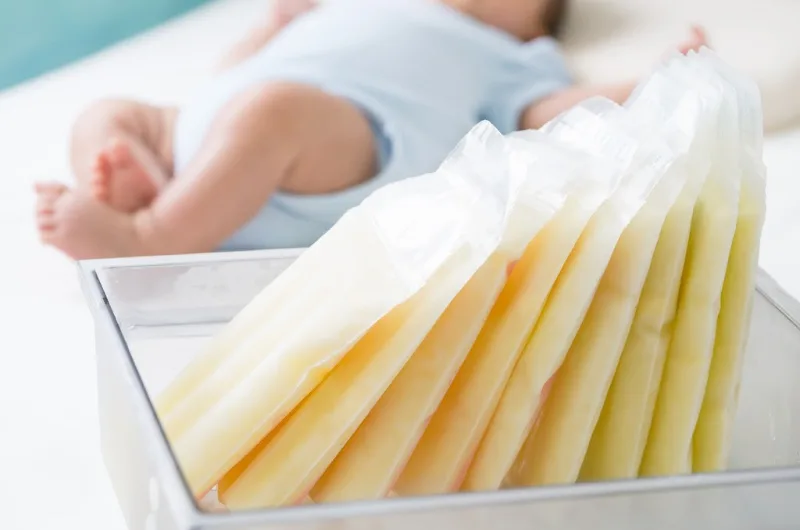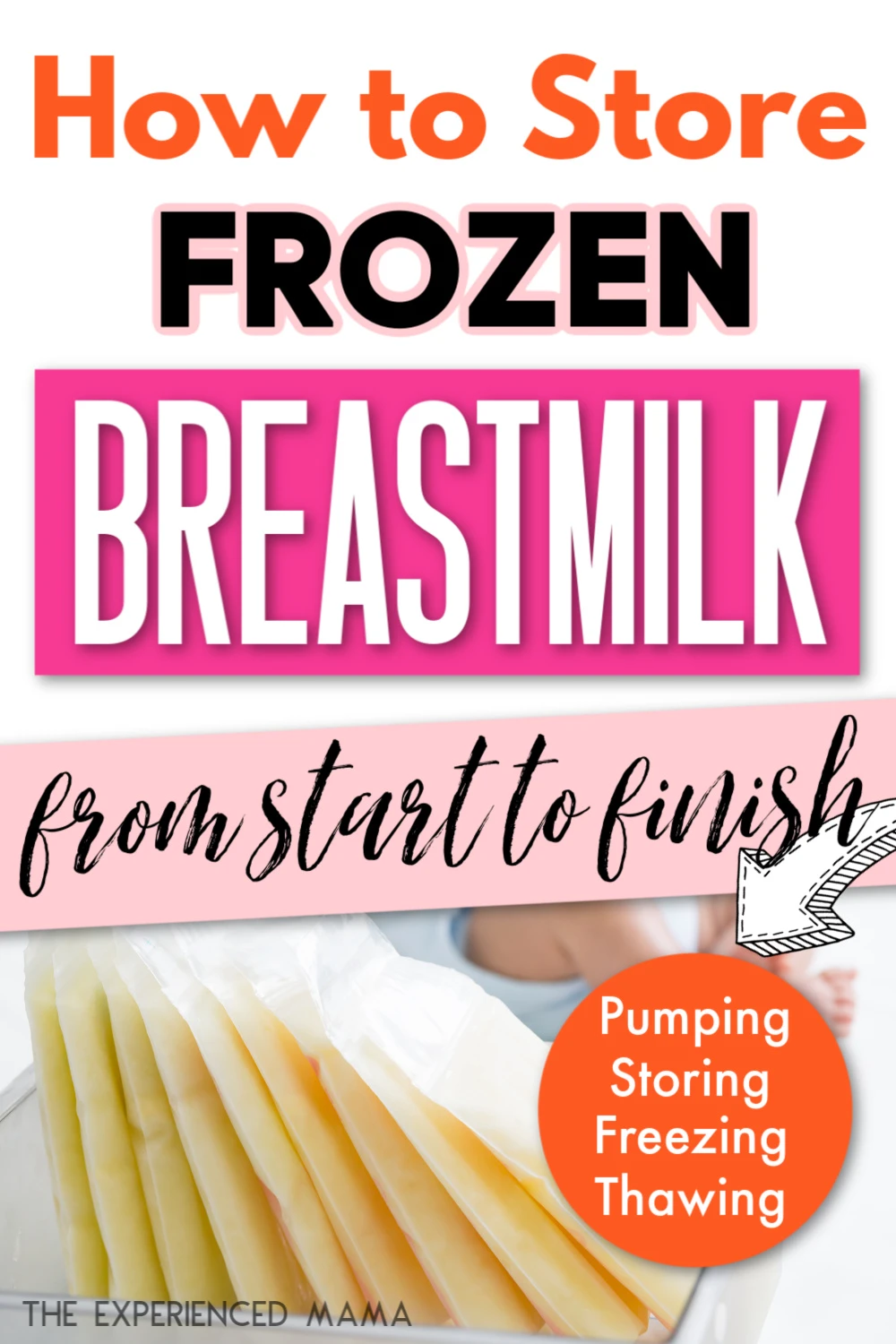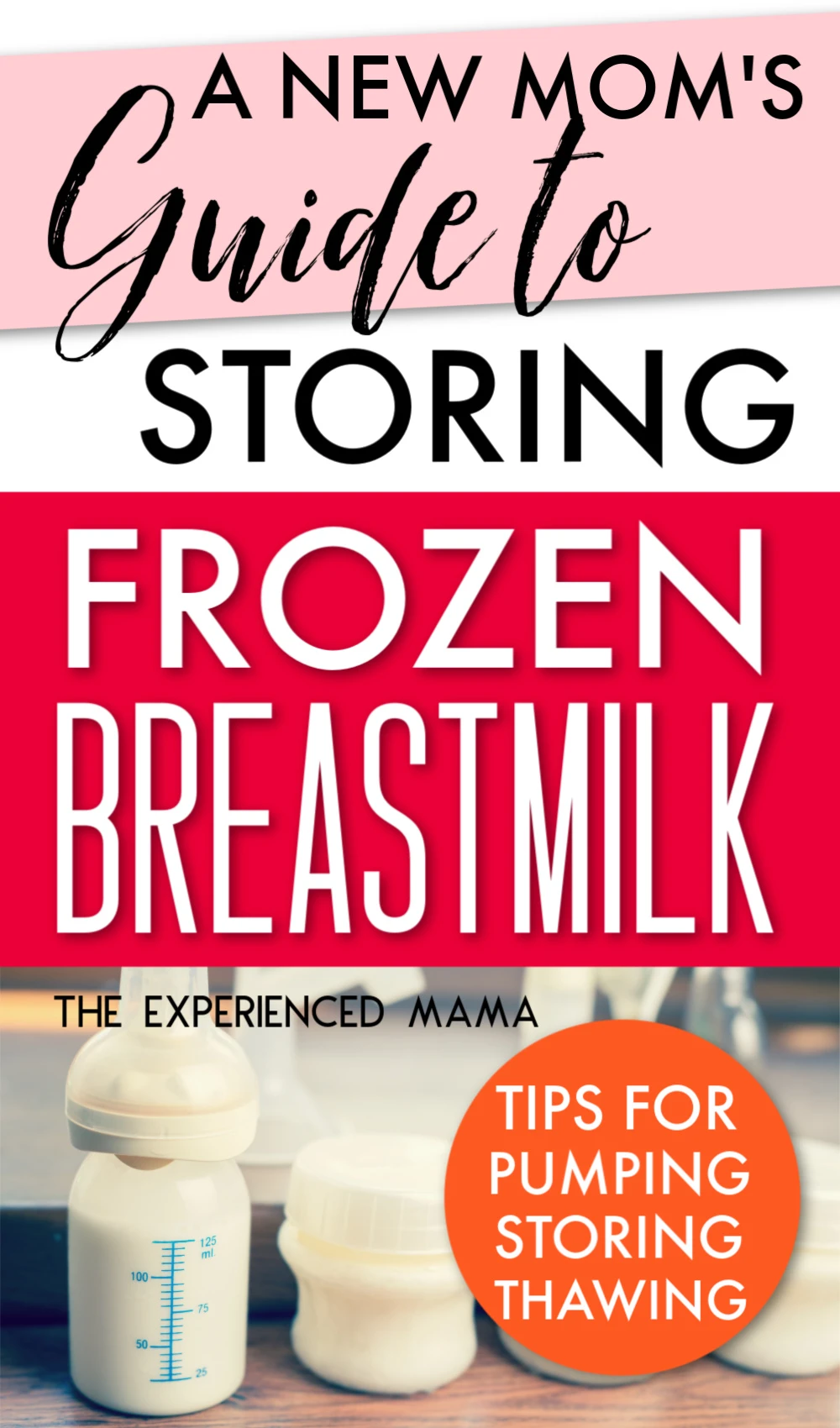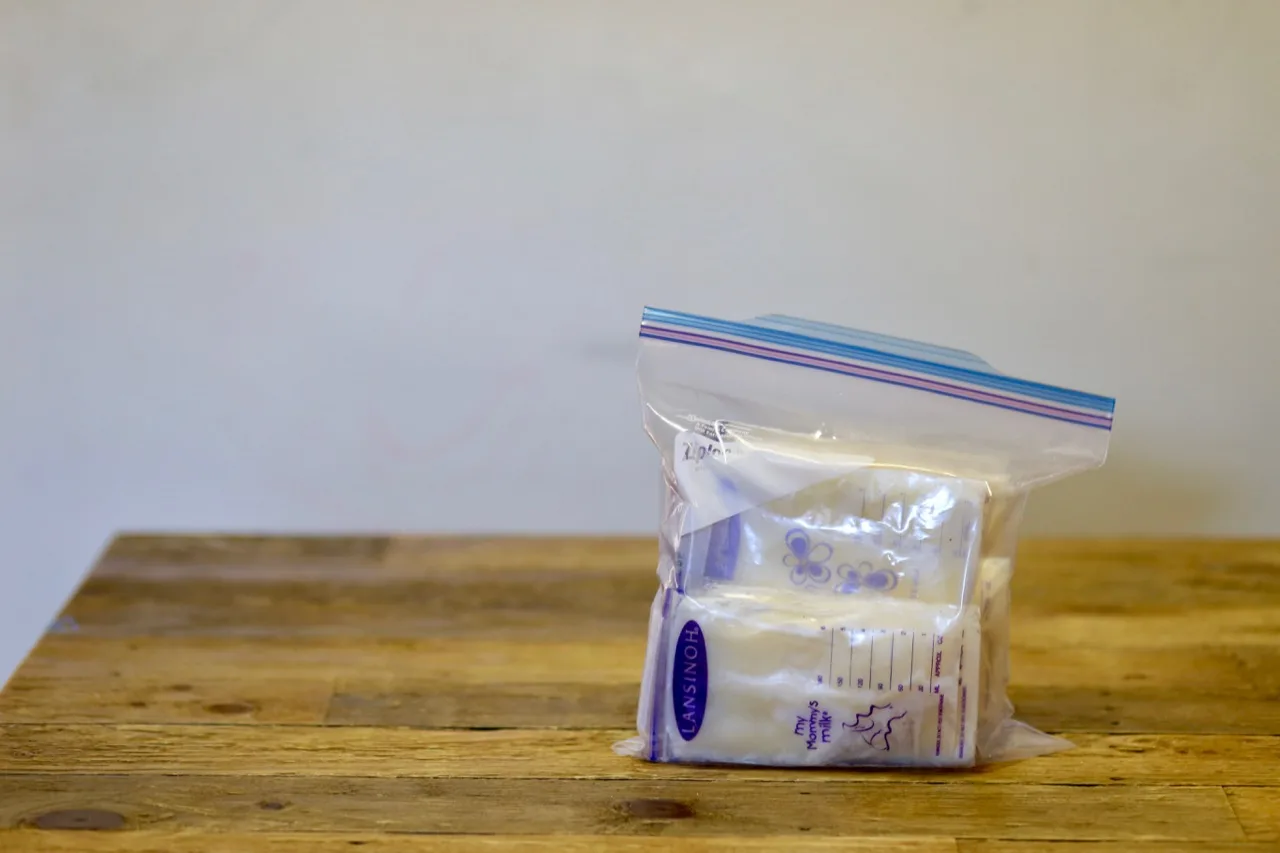Inside: Learn how to store frozen breast milk – get all the basics and helpful tips for pumping breast milk, freezing it to maximize storage space, thawing frozen breast milk and how to warm breast milk once it’s thawed.
So you’ve figured out breastfeeding – you’re basically a rockstar. You can do hard things, mama! But if you’re like most breastfeeding moms, you are also planning on pumping and freezing breast milk.
And learning how to store frozen breast milk? More goes into that than you might think (isn’t that all things new baby, though?).
You’ll need to learn:
- How to pump your breast milk (the basics)
- Figure out the best way to freeze breast milk
- How to properly thaw that breast milk, and
- How to heat up breast milk safely before you actually feed the baby
Who knew pumping breast milk could be so much flipping work?!
Deep breaths: you can do this.
With practice, pumping and storing breast milk will become easier and easier, until it’s just like riding a bike.
Like any seasoned breastfeeding mom, you’ll be a pro at everything from how to get the best milk while pumping to how to store breast milk in the freezer in a way that maximizes the space.
There’s more to storing frozen breast milk than just sticking it in the freezer and calling it a day. It requires a bit more care for the best (and safest) results.
Get tips from a seasoned breastfeeding mama when it comes to pumping and storing your frozen breast milk!
Related: 11 Easy Breastfeeding Snacks to Grab for Late Night Feedings

Pumping Breast Milk: A Brief Overview
THIS POST CONTAINS AFFILIATE LINKS. IF YOU LIKE LEGAL JARGON, YOU CAN READ OUR FULL DISCLOSURE POLICY HERE.
The first part of this process is actually pumping said breastmilk. And no, I’m not going to tell you to get up at the crack of dawn in order to pump as much as possible only to breastfeed your baby right afterward.
I’ve gotten advice like that (and tried it). I realized it wasn’t sustainable for the average breastfeeding mama.
You need your sleep, girl!
Also, full disclosure: I’m not a pumping expert.
If you want the full and complete guide, including trouble-shooting, you’re gonna want to grab this affordable online pumping course from Milkology.
When Should I Start Pumping?
If you’re getting advice about when to start pumping, you need to keep in mind where that advice is coming from.
Moms pump for all kinds of reasons, and their pumping advice is going to be based on their needs, not yours.
Most pumping advice differs based on how frequently you will be using stored breast milk.
If you’re the mom who needs four bottles a day because you’re going back to work, you’re obviously going to need to pump a lot more than the mom who just wants her husband to take the occasional night shift to give her a break now and then.
Establish a breastfeeding routine before you start pumping breast milk for future use.
This means ideally waiting until your baby is six-weeks-old, as that’s when your milk is fully established and your body understands how much milk to make.
I understand that’s not always possible (insert: rant on paid maternity leave coverage in the U.S.), so just wait as long as you can up to that point to avoid oversupply. You don’t want to send the wrong message to your body and make it think you are feeding quintuplets!
Your body works on a supply and demand system, so the more you express, the more it will produce. Don’t overdo it!
(On the other hand, if you are struggling with a low milk supply, check out these breastfeeding smoothie recipes to boost your supply naturally!)
Oversupply can become a problem for all kinds of reasons ranging from baby not getting enough of the right kind of breast milk to you feeling uncomfortably full a lot of the time. Learn more about breast milk oversupply in this article.
Aside from that… start pumping when you feel the time is right.
- If you’re returning to work, you might want to start a few weeks ahead of when you need to be back at work.
- If it’s for the occasional date night, put it off as long as you can and don’t pump too much.
- If it’s for engorgement relief, start as soon as you need to, but pump only until you feel relief and avoid fully emptying the breast.

How to Pump Breast Milk: The Basics
So, how do you pump, anyway? Well, there’s a few things to consider here.
1. Gather all the supplies you need, such as:
- Hospital grade electric breast pump
- Storage bags or bottles
- Bottles for breastfed babies
- Pumping bag
2. Make sure everything is clean and sanitized.
Before you sit down, make sure everything is clean. This means washing hands, bottles, pump parts, etc.
3. Pump at all times of the day, if possible.
Many will say to make sure to pump in the morning because your supply is the best.
While this isn’t wrong… it’s not completely right, either. The information I’m about to share will blow your mind about how awesome your body is.
Your body produces different hormones at different times of day so you want to pump and label at different times. This helps you make sure that babe gets “sleepy milk” and “awake milk” at the right times throughout the day.
4. Create the ideal schedule and environment for pumping.
To ensure the best results, you’ll want to create a routine and schedule if you’re pumping on a long-term basis. Additionally, you want to be in an environment that encourages letdowns.
Find a quiet place, think of your baby, and relax the best you can while you pump. The lower your stress is, the better.
If you find yourself obsessing (stressing) about how much is or is NOT going into the bottle, some women find that putting a sock over the bottle or bag can take your mind off of it.
Which leads me to the next part of this…
How Much Breast Milk Should You Pump?
This is another reason to wait until you have your supply and routine established. It will really help when knowing how much to pump.
You only want to pump as much as needed, and nothing more.
You may want to start out with only 2-3 ounces per bag and add more as needed.
You cannot refreeze breast milk, so it’s better to use more bags than to have to throw away the leftover milk.
You also want to pump to replace the milk sessions babe is having. Don’t pump more than they are consuming in a day or you may end up overproducing.
Now that we’ve covered pumping, let’s talk about how to store frozen breast milk.

How to Store Frozen Breast Milk
Storing the breastmilk isn’t quite as simple as tossing that bag of breast milk in the freezer. There’s a few things you need to know first.
1. Decide which breast milk storage containers you want to use.
As with most things, there are so many options for storing breast milk today!
You can choose from:
- Plastic storage bags (I used THESE)
- Plastic bottles
- Glass jars or bottles
Plastic storage bags are ideal for maximizing space in the freezer. But glass breast milk storage containers can also be a great option if you have a deep freezer or a lot of unused freezer space.
I only used plastic storage bags when I was pumping, but ten years later, I’m a little more environmentally aware than I was, so I decided to look into glass for breast milk storage.
From my brief research, there are more complications when it comes to choosing glass storage containers because certain types of glass are not designed for freezer storage (these ones are). Glass can shatter if thawed too quickly, and you don’t want all your hard-earned breast milk to go to waste!
You also want to make sure you don’t fill glass containers to the top in order to make room for expansion that will happen in the freezer.
If you decide to go with glass breast milk storage containers, make sure to choose ones specifically designed for breast milk storage.
2. Store pumped breast milk in small amounts.
Heated breast milk is only good for a few hours. Safety guidelines suggest two hours, but that’s very conservative.
To ensure your hard work doesn’t go to waste, store breast milk in 2-4 oz. per container and thaw only what you need right away (source).
3. Precisely label your containers of breast milk.
It’s very important to write out the amount in the container, the date, and the time!
You can opt to only put AM/PM, or to put the exact time. Because your milk can contain higher levels of melatonin at night, this ensures babe gets the best milk for that time of day to not disrupt a well-established circadian rhythm.
If your baby will be attending daycare, writing their name may also be a good idea as well, in order to avoid any mix-ups.
4. Place your breast milk in the freezer.
Now it’s time to place your breast milk in the freezer! But don’t just throw it in there.
If you’re wondering how to store breast milk in bags, make sure to seal completely with as little air as possible left in the bag. This is the absolute best way to allow the breast milk to freeze as it maximizes space available.
I also suggest laying it down flat in the freezer for the initial freezing. Then move it to a breast milk storage container of some kind once it is fully frozen to keep is separate and organized.
You can use an old soda can box or you can purchase containers specifically designed for freezer storage like this one.
I have these freezer bins in different sizes and they definitely help keep things organized!
How Long Can You Store Frozen Breast Milk?
You got your milk pumped, containers prepped, and have frozen your milk in the freezer. You’re on a roll!
So… how long can you store frozen breast milk anyway? And while we’re on the subject, what about storing fresh breast milk or leftover thawed breast milk?
Here are the exact guidelines according to the CDC depending on the state of your milk.
- Frozen milk is good for roughly 6 months ideally, but some say it’s still acceptable up to 12 months
- Milk that is pumped and then put in the refrigerator is good for about 4 days
- Milk that is thawed and then put in the refrigerator is good for about 24-hours
- Milk that has been sitting on the counter at room temperature is good for about 4 hours
It’s also good to note the temperatures at which you can safely store breast milk.
- Frozen milk: 0°F or cooler
- Refrigerator: 39°F or cooler
- Room temperature: 77°F or cooler
How to Thaw Frozen Breast Milk (Safely)
Once you’ve frozen your milk, you may need to thaw it out. While you might be tempted to throw it in the microwave – this is dangerous and not at all recommended.
Why? Because microwaves heat unevenly and damage the milk or far more importantly, cause hot spots and burn your baby’s mouth.
There are two ways you can thaw breastmilk: slow and steady, or quickly.
Choose slow and steady if possible.
If you can, throw the frozen milk in the fridge at least 12 hours ahead of time. If possible, avoid thawing out on the counter as the temperature is quite high for thawing.
Things happen so sometimes this isn’t possible and that’s okay! You can always thaw in a quicker manner, when needed.
Be cautious when thawing quickly.
When thawing quickly, avoid putting a bottle in boiling water or putting it in the microwave for reasons outlined above.
Instead, run it under water starting with cold, slowly increasing the temperature of the water.

How to Warm Breast Milk After Thawing
When warming thawed or refrigerated breast milk, you can use a few different methods, depending on the amount of time you have:
- Place the bottle into a cup of warm water.
- Use a bottle warmer (be cautious not to overheat!).
- Leave it out on the counter until it reaches room temperature (don’t leave out longer than 4 hours once it warms up).
Never use boiling water as it can warm the breast milk too quickly, and never ever microwave it!
As I’m sure you know from heating up leftover food, microwaves heat unevenly, which can cause dangerous hot spots.
According to this study, overheating breastmilk can also cause it to lose some of its nutritional value. You worked hard to pump that breastmilk, and you want your baby to get all the benefits.
Make sure to test the breast milk on your wrist before feeding your baby.
Can You Reuse a Leftover Bottle of Breast Milk?
While breastfeeding moms certainly take their liberties when it comes to using leftover bottles of breast milk (because: it’s liquid gold!), it’s not the safest option.
According to this article, the main concern is the bacterial contamination from the baby’s mouth. Opinions from breastfeeding experts vary widely, and no official studies have been done.
Read the full article on reusing leftover bottles of breast milk at Kelly Mom HERE.
Use your judgment, but know that reusing breast milk bottles that have been partially fed to your baby is not recommended.
Freezing Breast Milk: Key Takeaways (Because That Was a Lot of Information!)
I hope this post helped clear up any questions you might have about how to store frozen breast milk! Here are the key takeaways:
Start pumping when you feel the time is right, and you aren’t at risk for overproducing.
Get your supplies, make sure everything is clean, pump at various times of day, and do so in the best environment and schedule possible. Be careful not to pump more than your baby needs!
Once you’re ready to store your milk in the freezer, prepare your containers and label them. Lay them flat and place them in the freezer for maximum storage space.
It’s also important to know when and what temperature you might have to throw away your milk. This varies, so make sure to refer to the guidelines above as needed!
When it’s time to thaw out your frozen breast milk, avoid using a microwave or pot of boiling water as it can be risky for the state of the milk and risks of burning.
Thaw it out in the refrigerator ahead of time if possible, and hold it under running water if you need it quickly.
P.S. Don’t forget to check out this comprehensive online course on all things pumping!
Do you have any tips or hacks when it comes to storing frozen breast milk? Share below!
Read Next: 12 Good Reasons to Stop Breastfeeding – Guilt-Free

Owner of Growing Serendipity, June could talk to you all day about homeschooling, parenting, and minimalism, which she does at This Simple Balance. When she’s not homeschooling, decluttering, or blogging, she loves to enjoy perfect silence while sipping a hot cup of coffee and thinking uninterrupted thoughts—which, of course, with five kids, doesn’t happen very often.